
Piazza del Popolo or People’s Square is one of the stunning city squares in Rome. This ellipsoid piazza is surrounded by three churches, it has an Egyptian obelisk in the middle of it and a belvedere that offers an amazing view of the city bellow.
Piazza del Popolo is an enormous and famous city square in Rome. In modern Italian, Piazza del Popolo means “People’s Square”, but it has been suggested that the name is derived from Latin “populus” which stands for a tree family to which belong: poplar, aspen and cottonwood. This may have happened because of trees that were planted near the Imperator Nero’s tomb, placed next to the piazza.
In the center of the square there is an ancient Egyptian obelisk. On the one side of the piazza there are two twin churches built in the 17th century: Santa Maria in Montesanto and Santa Maria dei Miracoli. On the opposite side there is an ancient Roman gate (which was a part of so called Aurelian Walls, built during the reign of Imperator Aurelian) called Porta Flaminia. This gateway was on the road to north (Via Flaminia), and it was the first thing that would see the travelers from the northern parts of Italy before entering the city. Next to the gate there is Basilica Santa Maria del Popolo, the oldest church on the square that was built on top of the Imperator Nero’s tomb by Pope Pasquale II in 11th century. This church was financed from the pockets of the people of Rome (Italian: “popolo”) which is why it is called “del popolo” meaning - belonging to the people. One of the possible theories is that the whole square got its name from the name of this church.
(!) While standing in the square you’ll notice a belvedere on one side of the piazza called Terazza del Pincio. It is possible to reach it on foot, and it offers the best view of the piazza, a part of Rome and Saint Peters Cathedral. Do not miss it!
Interesting facts